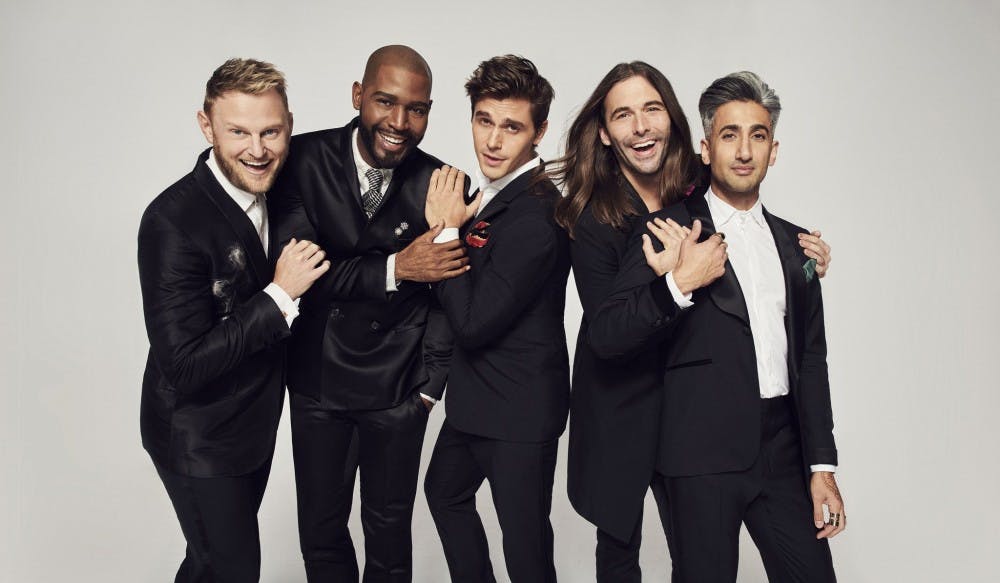After much anticipation and perfect to distract from the onslaught of midterms and papers, the newest season of Queer Eye finally made its way to Netflix March 15. And with a move from a home base in Atlanta to one in Kansas City, Missouri, this season may just be the best one yet.
“Queer Eye,” Netflix’s reboot of the famous Bravo show “Queer Eye for a Straight Eye,” has taken the world by storm. The Fab Five, all experts in various fields — Antoni Porowski in food and wine, Karamo Brown in culture, Tan France in fashion, Bobby Berk in design and Jonathan Van Ness in grooming — have become household names after the success of the first two seasons of “Queer Eye.”
Critics and audiences are falling in love yet again with this group of men in what some are calling “the most compassionate season yet.” Even their promo trailer promotes this message of positivity and self-love, saying that, above all, “this is the season to love yourself.”
The third season opens with this powerful message through the 49-year-old Jody, a camo lover and expert hunter in Kansas City, Missouri, struggling to define her own untraditional version of femininity. To accommodate her style, Karamo brings her to a group of women who each define their feminity differently, proof of the multiplicity of the female experience. And right off the bat, the audience is reminded that this makeover show is about more than physical appearance.
One dramatic improvement this season is in the levels of chemistry and comfort between the members of the Fab Five. Not only did this add entertainment value to the show, but it improved the makeover themselves. The team could work much more collaboratively and therefore, more effectively, with each makeover they did. And, in many cases, Bobby or Karamo would take another member of the Fab Five with them to work with each client, building a greater sense of community within the cast.
Additionally, unlike in previous seasons, the focus seemed to be on identity, rather than political issues or divides that seemed to take up the forefront of season one and two. And the audience is left with a greater understanding of the many ways that identity can be expressed and can intersect. Each individual's identity was made up of many pieces and components, not simply queer or straight, or feminine or masculine.
And, in some ways, the season one and two discussions surrounding controversial topics felt artificial, making season three the most human yet. When these divisive conversations do arise in season three, like a conversation in the first episode where Tan and Jody find that they agree on many gun control issues, they happened organically and breathlessly, without the forced formulaic structure of prior seasons.
Another big difference from prior seasons comes in the representation of Karamo Brown and his role in the show. The audience finally got to know what Karamo’s culture portion truly meant and how it transformed the individuals in the show. Karamo’s job is not unlike a detective, uncovering dark pasts and personal struggles to reveal ultimately stronger more confident people. In some cases, he helps a woman become confident her black and queer identity and in other cases, he broke down walls, literally and metaphorically, for a young man plagued with insecurities. And every moment he works with the clientele are sure tear-jerkers for everyone watching.
What made season three so special was that it continuously broke from its repetitive formula of the Fab Five reinventing and improving the lives of straight men, making the show much more human and organic. For one, this season brought new levels of diversity, with equal numbers of men and women represented. It was a better representation of the world than “Queer Eye,” or really any makeover show, has provided. And, for another, the changes this season emphasized building confidence rather than artificially creating it with clothes and makeup by addressing internal struggles to learn self-love.
The concept of a makeover show seems to go against of the very idea of self-love or an acceptance of one’s many identities, opting for physical changes to “improve” people. Yet, ultimately, “Queer Eye” is proof of what a makeover show can be: a place where confidence and beauty can grow. And its third season perfectly embodies that.
Get The Chronicle straight to your inbox
Signup for our weekly newsletter. Cancel at any time.

